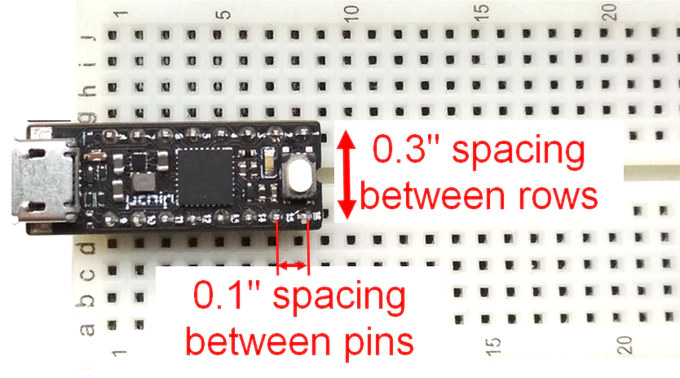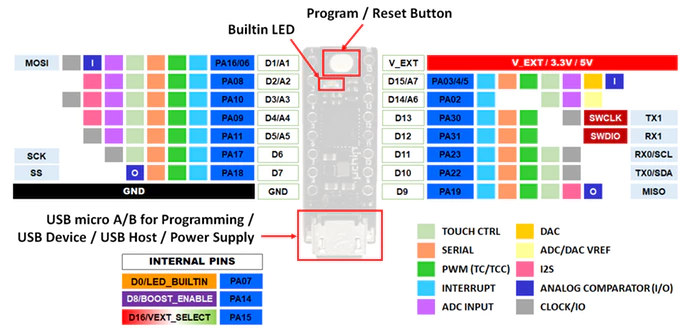Most so-called breadboard-friendly boards that can easily be inserted into a breadboard often leave only one or two rows to play with on each side. This may suitable in many cases, but some people really want to use as many rows as possible, and come up with a solution using 90 degrees headers with 0.3″ spacing between them, just like 0.3″ wide chips do, and allowing the use of 4 rows on each side of the board. It does the trick, but this is not a standard solution, requires some bending of the headers, and covers part of the board so it’s not really ideal.
A better way would be for somebody to design a narrow board using headers with 0.3″ spacing, and that’s exactly what Itaca Innovation has done with their Arduino Zero compatible uChip board designed in a 16-pin DIP package.
uChip specifications:
- MCU – Microchip SAMD21 Arm Cortex M0+ MCU clocked @ 48 MHz (Arduino Zero Compatible) with 256 KB flash (248 KB free due to integrated bootloader), 32KB RAM with zero wait states.
- I/Os via 2x 8-pin headers with 2.54mm pitch, 0.3″ (7.62 mm) row spacing
- 14x I/O pins including two that can be used to connect an external SWD programmer/debugger
- 7x 12-bit ADC inputs.
- 10-bit DAC output.
- 14x external interrupt input pins.
- Up to 5x serials between SPI, I2C and UART.
- I2S port for audio decoders such as UDA1334A.
- Up to 13x PWM pins.
- 2x power pins (VCC and GND)
- 14x I/O pins including two that can be used to connect an external SWD programmer/debugger
- Misc – Programmable Status LED, multi function push button for reset/program.
- Power Supply
- 5V via micro USB port, or 3.3V to 5V via pin
- Integrated 500-mA boost and 1-A buck converters and automatic power switching circuitry.
- Dimensions – 28.5 mm x 10.16 mm including USB port protrusions (4-layer board).
Each converter can also be individually turned off, so for instance, you could force power draw exclusively from external pins, or turn off an external USB device connected with a micro A cable. When powered through the USB port (5V input), the output voltage on the power pins can be selected via software to be either 3.3V or the USB voltage.
uChip can be programmed like an Arduino Zero board, but the company also developed uChip-specific libraries, which handle power supply management, a better USB host support and VGA output. Everything will be open sourced including code samples, the schematics, and Gerber files.
The board has just launched on Kickstarter with a 21,000 Euros funding target. Perks start at 20 Euros for one board, but they also offer bundles with up to 10 boards for a unit cost of 13.6 Euros. Shipping adds 1 or 2 Euros to the total cost, and delivery is scheduled for October 2019.

Jean-Luc started CNX Software in 2010 as a part-time endeavor, before quitting his job as a software engineering manager, and starting to write daily news, and reviews full time later in 2011.
Support CNX Software! Donate via cryptocurrencies, become a Patron on Patreon, or purchase goods on Amazon or Aliexpress






